Introduction
Poker app development is rapidly emerging as a top trend in the digital gaming industry. Whether you’re a startup aiming to enter the market or an established gaming brand looking to expand your portfolio, developing a poker app can be a highly lucrative venture.
This comprehensive guide will walk you through every essential aspect of poker app development. You’ll gain insights into market demand, gameplay mechanics, key features, monetization strategies, and the overall cost of development.
Now is the perfect time to tap into the booming online poker industry and create a mobile experience that attracts, engages, and retains players.
1. Planning and Market Research for Poker App Development
Before diving into development, thorough planning and market research are essential to ensure your poker app meets user expectations and stands out in a competitive landscape.
This foundational phase helps define your target audience, identify industry trends, and shape your app’s core features and business strategy.
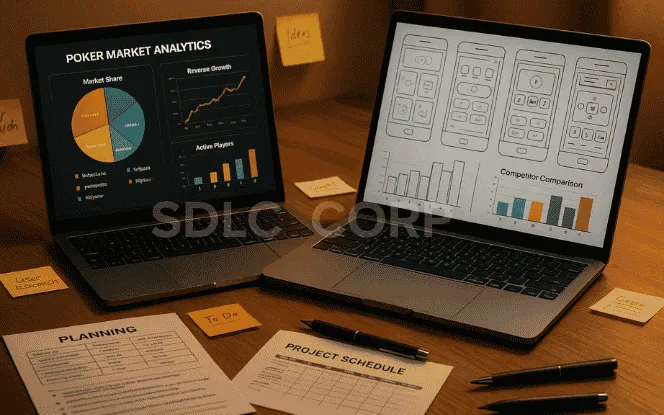
Key Considerations During Planning
- Define Your Target Audience: Determine who your users will be. Are you targeting casual players, competitive poker fans, or professional gamers? Understanding user behavior helps tailor the design, gameplay, and features.
- Conduct Market Research: Analyze the online poker industry to discover what types of apps are trending, what users prefer, and which formats (Texas Hold’em, Omaha, etc.) are gaining traction.
- Perform Competitive Analysis: Study leading poker apps to evaluate their strengths and weaknesses. Look into user reviews, features, design patterns, and monetization tactics. Use this data to build a better, differentiated product.
Poker App Development Roadmap:
- Choose the Right Platform: Decide whether to launch on iOS, Android, or both. Consider cross-platform development for wider reach.
- Understand Legal and Compliance Requirements : Research the legal regulations related to online poker in your target regions. Ensure compliance with local laws, especially around age restrictions and real-money gaming.
- Select a Business Model : Choose a monetization strategy that fits your audience and goals. Options include freemium models, in-app purchases, subscription plans, or real-money gameplay with legal licensing.
Start Your Poker Game Adventure Today and Watch Your Success Roll In!
2. Design Phase: Building a Visually Engaging and User-Friendly Poker App
In the design phase, your focus should be on creating a poker app that is not only visually attractive but also simple to navigate. A strong user interface combined with a smooth experience ensures that players stay engaged and return to play regularly.
This phase involves translating your game’s concept into actual visual components and user interactions. Every element should work together to provide a seamless, enjoyable experience.
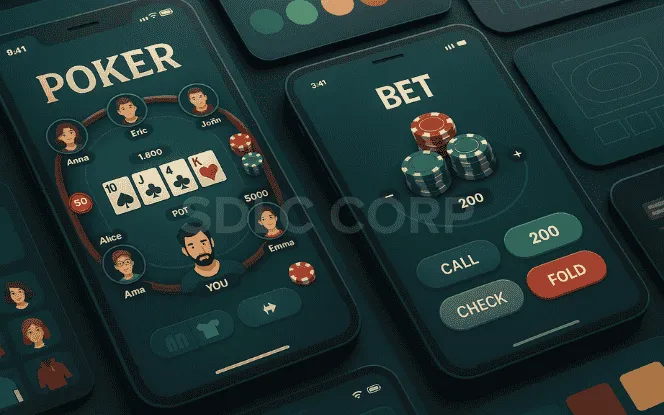
Essential Design Considerations :
- User Interface (UI) : Design a clean and intuitive interface. Players should be able to understand game mechanics at a glance without needing instructions. Avoid clutter, use a consistent layout, and highlight key elements like betting controls, chips, and table settings.
- User Experience (UX): Make performance a priority. Minimize loading times, ensure fast response to user inputs, and create a consistent experience across all screens. Smooth animations and easy navigation can significantly improve user satisfaction.
- Game Visuals and Branding : Develop poker tables, cards, chips, and avatars that reflect your brand identity. Visual elements should be both engaging and professional, offering players a premium gaming atmosphere.
Key Design Features Overview
| Feature | Description | Why It Matters |
|---|---|---|
| UI/UX Simplicity | Easy-to-use design with straightforward navigation | Increases usability and helps retain users |
| Custom Avatars | Allows users to personalize their gaming identity | Boosts engagement through player customization |
| Responsive Layout | Fully compatible with various screen sizes and resolutions | Ensures a smooth experience on phones and tablets alike |
3. Development Process: Bringing Your Poker App to Life
Once the design phase is finalized, the next step is the development process. This stage involves building both the front-end and back-end components of your poker app, ensuring a fully functional and scalable product.
Choosing the right technologies and experienced developers is essential to delivering a smooth, secure, and interactive gaming experience.
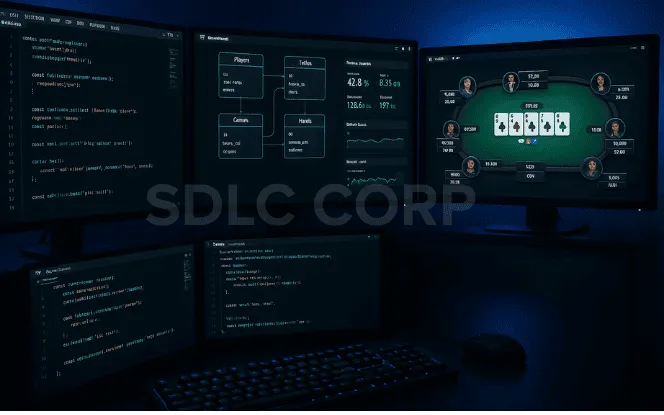
Key Stages in Poker App Development :
- Front-End Development : This involves everything users interact with, including the game lobby, poker tables, player profiles, chat features, animations, and in-game navigation.
- Back-End Development : This layer manages server infrastructure, player authentication, game rules logic, real-time data exchange, and secure database handling.
Technology Stack and Frameworks :
To build a robust and scalable poker app, your development team should use proven technologies and cloud solutions that support real-time multiplayer gameplay.
Recommended Infrastructure and Technologies :
- Partner with Experts : Consider hiring a poker software development company that specializes in real-time, multiplayer game apps. Their experience can help you avoid common pitfalls and accelerate delivery.
- Reliable Server Technology : Use cloud platforms like Amazon Web Services (AWS) or Google Cloud to manage traffic surges, maintain low latency, and ensure consistent uptime.
- Real-Time Features : Integrate real-time updates for game actions, player moves, and chat interactions. This creates a seamless multiplayer experience without delays or lags.
Core Development Tools and Their Purpose
| Technology/Framework | Purpose |
|---|---|
| Unity or Cocos2d | Game engines for building interactive poker gameplay |
| Node.js and Express.js | Handle back-end logic and real-time communication |
| MongoDB or MySQL | Databases for storing user data and game history |
Successful poker apps are built on solid architecture, real-time synchronization, and scalable cloud-based infrastructure. With the right tools and an experienced team, you can create a poker app that delivers both performance and an exceptional user experience.
4. Testing and Quality Assurance (QA)
After development is complete, the next critical step is testing and quality assurance (QA). This phase ensures that your poker app is stable, secure, and functions seamlessly across different devices, operating systems, and network conditions.
Thorough testing not only improves the app’s performance but also enhances user trust and satisfaction—especially important for real-money gaming platforms.

Major Testing Phases to Include :
- Functionality Testing : Verify that all features work as intended. This includes game logic, user registration, in-app purchases, matchmaking, and chat functions.
- Usability Testing : Ensure the app is easy to navigate and intuitive for users. Gather insights on how players interact with your interface and whether any elements cause confusion.
- Performance Testing : Evaluate the app’s responsiveness under different conditions. This includes slow internet connections, high user loads, and multi-device usage.
- Security Testing : Confirm that all sensitive user data, including login credentials and financial transactions, is encrypted and secure. This is vital for maintaining trust and regulatory compliance.
Key Quality Assurance Practices :
- Use Automated Testing Tools : Tools like Selenium, Appium, or Jest can help accelerate testing cycles, identify bugs, and reduce manual workload.
- Conduct Beta Testing with Real Users : Before the official launch, release a beta version of your app to a controlled group of users. Gather feedback on gameplay, design, performance, and bugs. Use these insights to make final improvements.
5. Launch and Marketing Strategy for Your Poker App
Once your poker app is fully developed and tested, it’s time to prepare for launch and implement an effective marketing strategy. This step is essential to drive visibility, attract users, and start building a loyal player base from day one.
A successful launch is more than just uploading your app to the store—it requires a mix of pre-launch planning and post-launch promotions.
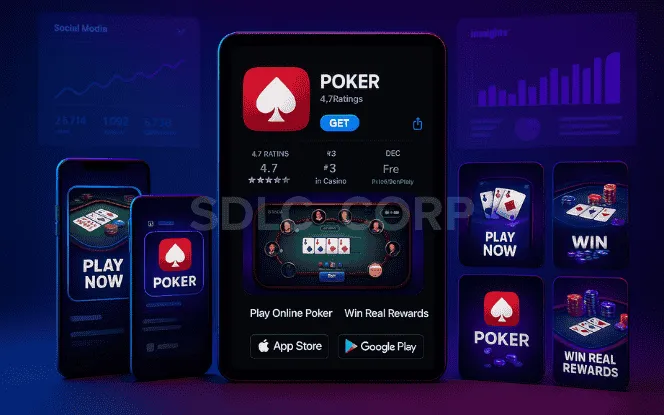
Pre-Launch Preparation :
- Create a Landing Page : Develop a dedicated landing page that highlights your app’s features, gameplay, and unique selling points. Use it to collect email leads and generate excitement before release.
- Conduct a Beta Launch : Release your app to a limited group of users. This helps uncover any overlooked issues and gives early users a chance to provide valuable feedback.
Post-Launch Marketing Techniques :
- App Store Optimization (ASO) : Optimize your app title, description, and keywords to improve discoverability in the App Store and Google Play. Add high-quality screenshots and demo videos to boost downloads.
- Paid Advertising : Run targeted ads on platforms like Google, Facebook, and Instagram to drive traffic and increase installs. Focus on audiences interested in gaming, poker, and real-money apps.
- Referral Programs : Encourage organic growth by offering rewards to users who refer friends. This not only boosts downloads but also builds a community around your app.
Effective Marketing Strategies
| Marketing Strategy | Purpose |
|---|---|
| App Store Optimization (ASO) | Increases app visibility in search results |
| Paid Advertising | Expands reach and drives targeted user acquisition |
| Social Media Campaigns | Builds brand awareness and engages your audience |
| Influencer Collaborations | Leverages credibility of poker or gaming influencers to reach niche communities |
6. Post-Launch Considerations: Enhancing and Supporting Your Poker App
Launching your poker app is just the beginning. To maintain momentum and ensure long-term success, it’s important to monitor app performance, respond to user feedback, and consistently improve the user experience.
Post-launch efforts help build user trust, improve retention, and keep your app competitive in a fast-moving market.
Key Post-Launch Activities :
- Monitor Analytics : Use tools like Google Analytics, Firebase, or Mixpanel to track metrics such as user engagement, session duration, churn rate, and in-app behavior. These insights help you make data-driven improvements.
- Bug Fixes and App Updates : Release regular updates to fix issues, optimize performance, and introduce new features. Frequent updates show users that the app is actively maintained and evolving.
- Customer Support : Offer responsive and accessible customer support. Addressing user concerns quickly helps reduce negative reviews and increases overall satisfaction and loyalty.
Post-Launch Best Practices
| Activity | Description |
|---|---|
| Analytics Monitoring | Track user behavior, app usage, and performance metrics |
| Regular Updates | Roll out new features and bug fixes to keep users engaged |
| Customer Support | Provide timely help to users through chat, email, or ticket systems |
Maintaining your app after launch is essential to grow your user base and stay ahead of competitors. With the right support and iteration strategy, your poker app can continue delivering value well after its initial release.
7. What Does Poker App Development Cost?
The cost of developing a poker app depends on several factors, including the app’s complexity, number of features, design quality, and the technologies involved. Whether you’re building a simple single-game app or an advanced, feature-rich platform, it’s important to plan your budget accordingly.
Below is a breakdown of the common pricing tiers and what each includes.
Cost Estimates Based on App Complexity :
- Basic Poker App
Estimated Cost : $10,000 to $25,000
This version typically includes one poker variant (such as Texas Hold’em), a basic user interface, user login, chip management, and simple gameplay mechanics. It’s ideal for startups or MVPs. - Multi-Variant Poker App
Estimated Cost : $20,000 to $35,000
Includes multiple poker formats like Omaha, 7-Card Stud, and Texas Hold’em. These apps feature multiplayer support, improved UI/UX, and additional functionality to attract a broader audience. - Advanced Poker App with AR/VR or AI
Estimated Cost : $35,000 to $50,000
Designed for a premium experience, these apps integrate technologies like artificial intelligence, augmented or virtual reality, smart analytics, and predictive features for enhanced gameplay.
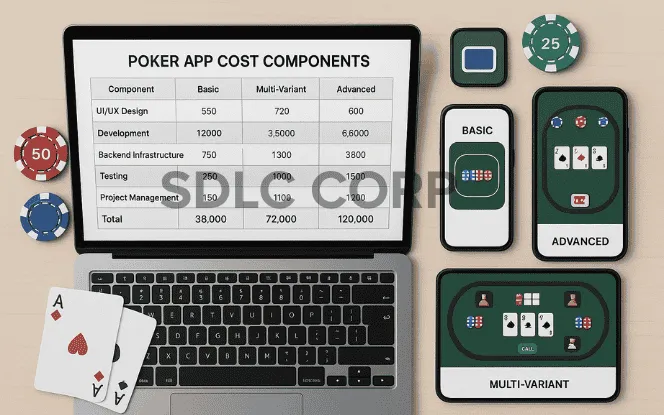
Detailed Cost Breakdown by Component :
| Feature | Cost (USD) | Details |
|---|---|---|
| Basic Poker App | 10,000 – 25,000 | Single poker game mode with core features and basic UI |
| Multi-variant App | 20,000 – 35,000 | Multiple poker types with multiplayer and enhanced visuals |
| Advanced (AR/VR/AI) | 35,000 – 50,000 | Includes AI bots, VR tables, or AR effects and data analytics |
| UI/UX Design | 8,000 – 20,000 | Custom user interface, interactive game layouts, intuitive flow |
| Payment/Security | 7,000 – 15,000 | Secure payment gateways, KYC, encryption, fraud prevention |
| Backend + Server | 6,000 – 18,000 | Scalable architecture, APIs, cloud server setup. |
| Post-Launch (Monthly) | 2,000 – 8,000 | Ongoing updates, bug fixes, server monitoring, and support |
Cost-Saving Strategy : If you’re looking for a faster and more affordable way to enter the market, consider using a white-label poker software provider. This allows you to launch your poker app quickly with scalable infrastructure and pre-built features, saving both time and development costs.
How Much Does Poker Game Development Cost? →
Conclusion
The online poker industry is booming, and with the right development strategy, you can enter this high-growth market with confidence. From user engagement to monetization, a well-executed poker app offers scalable opportunities and long-term profitability.
Whether you’re planning to build a simple poker app or a fully immersive multiplayer experience, partnering with a skilled poker app development company can accelerate your timeline and improve your product’s quality.
Now is the perfect time to turn your poker app idea into reality. Let our experts help you design, develop, and launch a winning game that players love.
Ready to bring your poker app vision to life? Let’s make it happen.
FAQ'S
What Is Poker App Development?
Poker app development refers to the process of creating mobile and web applications that allow users to play poker online. It involves designing the user interface, integrating game mechanics, securing payment methods, and ensuring a smooth user experience.
How Long Does It Take to Develop a Poker App?
The timeline for developing a poker app can vary depending on the complexity and features of the app. A basic app may take around 2-3 months, while a multi-variant or advanced app with AR/VR features could take 6-12 months or more.
What Are the Key Features of a Successful Poker App?
Successful poker apps should include smooth UI/UX design, multiple poker game variants, real-time multiplayer functionality, secure payment gateways, analytics dashboards, social media integration, and leaderboards/tournaments.
How Much Does It Cost to Develop a Poker App?
The cost of developing a poker app depends on features and complexity. A basic poker app might cost between $10,000 – $25,000, while multi-variant or advanced apps with AI/AR features could range from $20,000 – $50,000 or more.
Do I Need to Partner with a Poker Game Development Company?
Partnering with a specialized Poker Game Development Company can help ensure the success of your project. Their expertise in game mechanics, security, compliance, and user experience will help bring your vision to life more efficiently.



